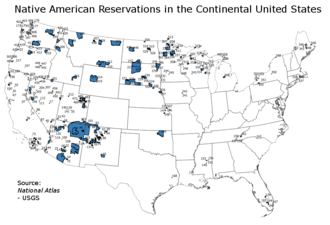| Indian reservations | |
|---|---|
| |
 | |
| Category | Autonomous administrative divisions |
| Location | United States |
| Created |
|
| Number | 326[1] (map includes the 310 as of May 1996) |
| Populations | 123 (several) – 173,667 (Navajo Nation)[2] |
| Areas | Ranging from the 1.32-acre (0.534 hectare) Pit River Tribe's cemetery in California to the 16 million–acre (64,750 square kilometer) Navajo Nation Reservation located in Arizona, New Mexico, and Utah[1] |
| This article is part of a series on |
| Political divisions of the United States |
|---|
 |
| First level |
|
|
| Second level |
|
| Third level |
|
|
| Fourth level |
| Other areas |
|
|
|
United States portal |


Tribal sovereignty in the United States is the concept of the inherent authority of Indigenous tribes to govern themselves within the borders of the United States.
The U.S. federal government recognized American Indian tribes as independent nations and came to policy agreements with them via treaties. As the U.S. accelerated its westward expansion, internal political pressure grew for "Indian removal", but the pace of treaty-making grew regardless. The Civil War forged the U.S. into a more centralized and nationalistic country, fueling a "full bore assault on tribal culture and institutions", and pressure for Native Americans to assimilate.[3] In the Indian Appropriations Act of 1871, Congress prohibited any future treaties. This move was steadfastly opposed by Native Americans.[3]
Currently, the U.S. recognizes tribal nations as "domestic dependent nations"[4] and uses its own legal system to define the relationship between the federal, state, and tribal governments. The U.S. recognizes 574 tribal nations, 229 of which are in Alaska.[5] The National Congress of American Indians explains, "Native peoples and governments have inherent rights and a political relationship with the U.S. government that does not derive from race or ethnicity."[5]
- ^ a b "Frequently Asked Questions, Bureau of Indian Affairs". Department of the Interior. Retrieved August 8, 2015.
- ^ "Navajo Population Profile 2010 U.S. Census" (PDF). Retrieved October 7, 2018.
- ^ a b "1871: The End of Indian Treaty-Making". NMAI Magazine. Retrieved July 11, 2020.
- ^ "Native American Policies". U.S. Department of Justice. June 16, 2014. Retrieved July 7, 2019.
- ^ a b "Tribal Nations & the United States: An Introduction". National Congress of American Indians. Retrieved June 6, 2024.